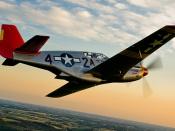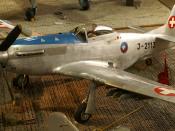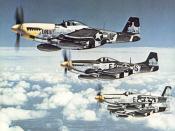P-51 Mustang w/ W.W.II
The effects of the P-51 Mustang in World War II
Abstract
This paper deals with the contributions of the P-51 Mustang to the eventual victory of the Allies in Europe during World War II. It describes the war scene in Europe before the P-51 was introduced, traces the development of the fighter, its advantages, and the abilities it was able to contribute to the Allies' arsenal. It concludes with the effect that the P-51 had on German air superiority, and how it led the destruction of the Luftwaffe. The thesis is that: it was not until the advent of the North American P-51 Mustang fighter, and all of the improvements, benefits, and side effects that it brought with it, that the Allies were able to achieve air superiority over the Germans.
This paper was inspired largely by my grandfather, who flew the P-51 out
of Leiston, England, during WW II and contributed to the eventual Allied success that is traced in this paper.
He flew over seventy missions between February and August 1944, and scored three kills against German fighters.
Introduction
On September 1, 1939, the German military forces invaded Poland to begin World War II. This invasion was very successful because of its use of a new military strategic theory -- blitzkrieg. Blitzkrieg, literally 'lightning war,' involved the fast and deadly coordination of two distinct forces, the Wermacht and the Luftwaffe. The Wermacht advanced on the ground, while the Luftwaffe destroyed the enemy air force, attacked enemy ground forces, and disrupted enemy communication and transportation systems. This setup was responsible for the successful invasions of Poland, Norway, Western Europe, the Balkans and the initial success of the Russian invasion. For many years after the first of September, the air war in Europe was dominated by...



Excellent!
Loved reading it. You had very vivid details throughout the paper, great reading!
5 out of 6 people found this comment useful.